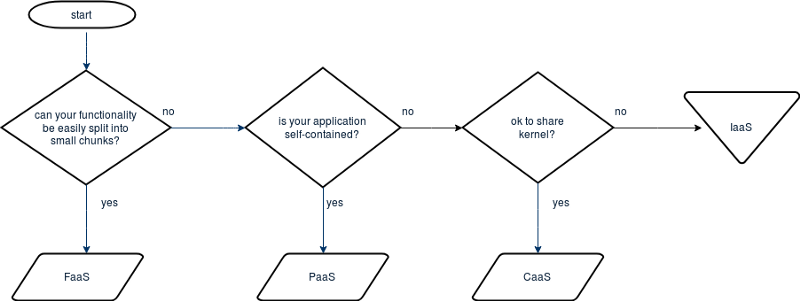When to use IaaS, FaaS, PaaS, and CaaS Or, how many aaS acronyms are there?
Newcomers to cloud computing might be a bit put off by the sheer number of acronyms in use, as there are a fair amount. In addition, just about everything is sold as a service (aaS) these days, even transportation. To try to clarify some of the available offerings, let’s have a look at some of these aaS acronyms, namely infrastructure as a service (IaaS), platform as a service (PaaS), containers as a service (Caas), and serverless, which is also known as function as a service (FaaS).
When trying to decide which of these offerings is most suited to you, one (not incredibly helpful) way to look at it is: how much money do you have to spend?
Plenty of cash
Let’s start with the most expensive solution and work our way down. If you have an unlimited budget, you might not need any of these offerings. You could buy your own building, fill it full of racks of servers and networking gear, and hire your own staff to install, run, and maintain it. You’ll probably need a fair share of air conditioning units as well.
But that isn’t likely the case. Even government entities with unfathomable budgets hire outside companies to run data centers for them. Why? Because realistically, doing all that yourself is quite a pain, and probably what brought about cloud computing in the first place. Which brings us to the first offering up for discussion: infrastructure as a service (IaaS).
The opposite of crumbling infrastructure
IaaS most closely resembles having your own data center. You get to control how many of whatever kind of machines you need, the network that connects (or separates) them, and the forms in which your data is stored. You can rent actual hardware or get virtual machines that behave just like them. This is the most expensive offering, but offers the most control.
That ends the usefulness of cost as an indicator of which offering is most helpful to you. It isn’t often that cost is your sole limitation, but it is probably a very important concern. A better decision could be made based on how complex your endeavor is. We can also look at this question in regards to your required level of control
Now arriving on platform one
While FaaS can be very useful for splitting up small tasks, it isn’t a good fit if you want to deploy a larger or more complex application. Platform as a service (PaaS) may be more to your liking. A platform such as IBM Cloud Foundry lets you publish, update, and scale your application without worrying about the kind of hardware it is running on. You gain a bit more control with a PaaS offering, like being able to specify the number of instances you run of your application and how much memory each of those instances are allowed to consume. With PaaS, your application is always running, as opposed to FaaS, where your code is only executed when needed.
Between the PaaS and IaaS offerings comes containers as a service (CaaS), where you get to specify a bit more about the environment in which your application is running, such as the operating system. As the name CaaS implies, you deploy one or more containers, as opposed to just an application with PaaS. It isn’t a full virtual machine, however, as it is sharing a kernel with other containers, which has its own security ramifications. A major benefit of CaaS is the ability to deploy multiple containers at the same time that work in conjunction with each other. In a larger deployment, you can have separate containers for the front-end of your application, its underlying database, search capability, log storage and processing, etc. All of which can be managed as one group, which is called a cluster.
One size does not fit all
Displaying the decision making process in a straight line, as I have done, is quite the misnomer. Especially because none of the above mentioned offerings are mutually exclusive. In the age of microservices, mixing any or all of these offerings together is a feasible reality for you to most effectively reach your desired deployment. It’s even possible to host a container as a cloud function. The resulting function isn’t always running so it wouldn’t be stateful, but it is a possibility. And the possibilities are almost as numerous as the amount of acronyms used to deploy them.
For Details Check here
https://developer.ibm.com/depmodels/serverless/articles/when-to-use-iaas-faas-paas-and-caas/

